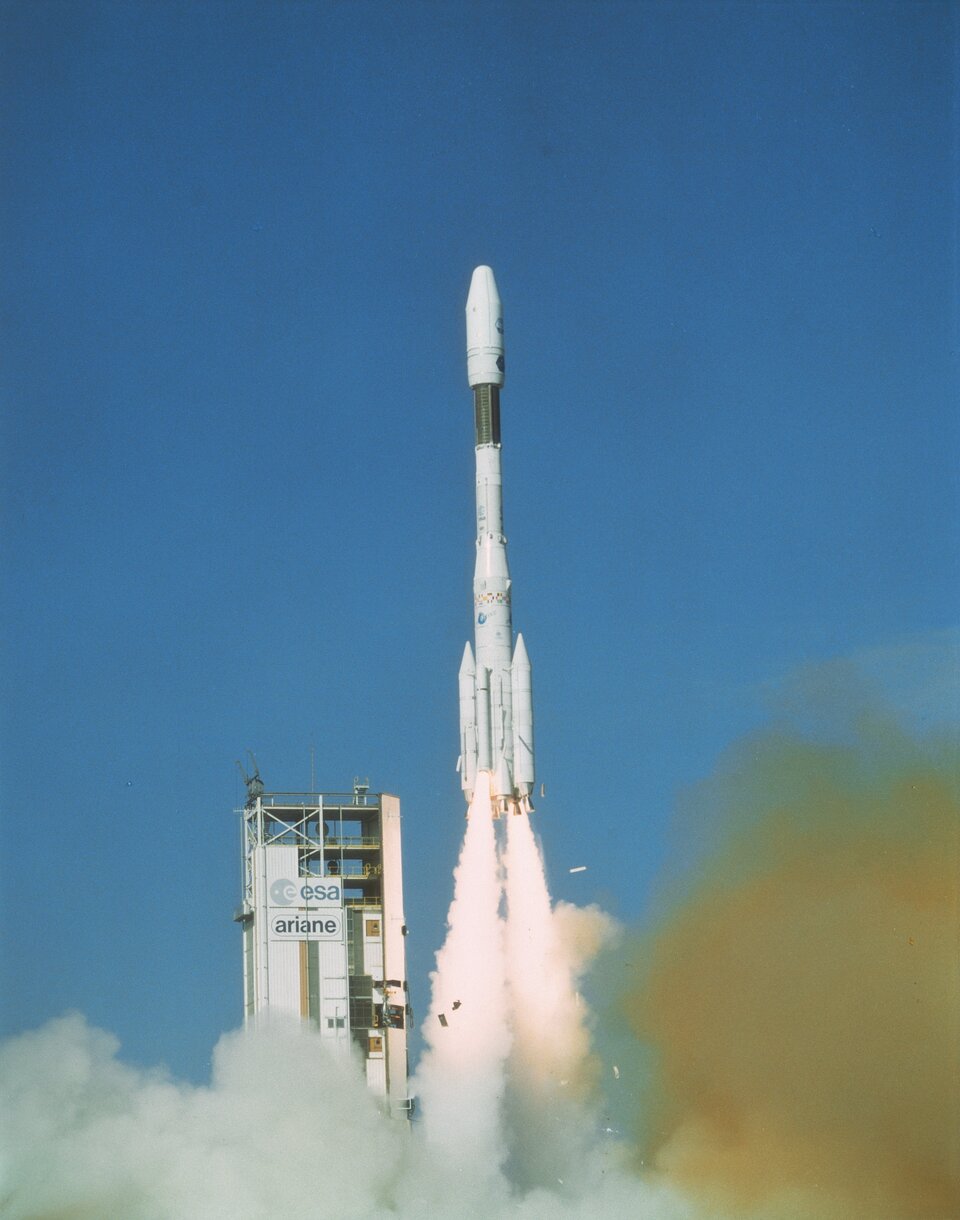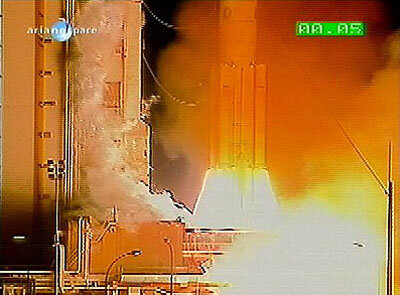History of the Ariane workhorse
Ariane 4 - often referred to as the Ariane workhorse received its 'honourable discharge' in 2003 after 15 years of faithful service.
Ariane 4 is the last version of the generation of launchers that all used the same technology:
- Ariane 1, launched between 1979 to 1986
- Ariane 2 and 3, launched between 1983 to 1989
- Ariane 4
Ariane 4 differed from its predecessors in several ways. The first stage was upgraded to carry 210 tonnes of propellant as compared to 140 tonnes; larger solid strap-on boosters and new liquid strap-on boosters were added to increase thrust in the early flight phase; the vehicle equipment bay was reorganised; and a 4 m diameter fairing and a new dual launch system were provided to cope with larger and heavier spacecraft. This meant that Ariane 4 could be launched in six versions to carry spacecraft with payloads ranging from 2000 kg to 4900 kg into geostationary transfer orbit. This compared to a maximum payload of 2700 kg for an Ariane-3 launcher.
Ariane-4 development commenced in 1982 after a short but intense preparatory programme initiated in 1981. The programme suffered from two Ariane-3 failures due to ignition problems with the 3rd stage cryogenic engine. Absolute priority was given to resolving this to minimise launch manifest problems.

Ariane-4 development culminated in the successful Ariane-401 demonstration flight that took place on 15 June 1988, placing ESA's Meteosat P2 and the Panamsat 1 satcom into orbit. The first Ariane-4 operational flight took place on 11 December 1988 launching the Skynet 4B and the Astra 1A spacecraft.
Major decisions
There are many prerequisites for successful development of a launcher: a strong and lasting political will; availability of the necessary financial resources; experienced and motivated government and industrial teams and appropriate structures; dynamic commercialisation; and, taking the right decisions at the right time. This last point may seem trivial and perhaps even naive, but it was one of the keys to Ariane's success. Throughout the programme proposals were made - and decisions taken - at the right time.
Some facts and figures
Technical/operational
- maximum GTO performance reached: 4946.9 kg (82nd launch)
- demonstrated reliability: 97.4% (113 successful launches out of 116); series of 74 consecutive successes (launches 43 to 116)
- operational flexibility: 14 launches in 12 months (March 1995 to March 1996)
- 116 Ariane-4 vehicles built: 7 Ariane-40, 15 Ariane-42 P, 15 Ariane-44 P, 13 Ariane-42 L, 26 Ariane-44 LP, 40 Ariane-44 L
- 728 powered stages built and launched (1st, 2nd and 3rd stages plus solid and liquid strap-on boosters)
Commercial
- 155 main payloads plus 27 auxiliary payloads delivered into orbit
- 155 main payloads: 139 for telecommunications, 9 for Earth observation, 5 for weather and 2 for science
- total mass launched (main + auxiliary): 404.1 tonnes, lightest - Itamsat 9.9 kg, heaviest - 4711 kg
- geographical breakdown of main payloads: Europe 34%, USA 19.1%, Asia/Middle East 14.4%, Japan 9.4%, America (- USA) 7.5%, international organisations 15.6%
- 50 satellite operators bought launches
- main customer Intelsat (18 Ariane-4 launchers for a total spacecraft mass of more than 74 tonnes)
Economic/industrial
- Government-funded development and associated activities (Ariane 1 development, Ariane 2/3 development, Ariane 4 development, product support) €2250 million
- Ariane 4 production turnover (money flowing back to European industry): €11 250 million
- Ratio of production turnover to government funding was approximately 4:1, a measure of the economic and industrial value of Ariane 4 and a strong factor in the drive to invest in Ariane follow-on developments. In simple terms it means that for every Euro invested by governments in development European industry received an extra workload worth €4.
- Industrial participation: companies in all ESA Member States worked on the launcher
Why discontinue Ariane 4?

In 1997 Arianespace ordered what turned out to be the last batch of 20 Ariane-4 launchers. Then in 2000 the decision was made to discontinue Ariane-4 production after this batch. Why this decision?
When Ariane 4 became operational in 1988 the Ariane 2 and 3 versions were discontinued rapidly, after a reasonable overlap with Ariane 4 for the sake of commercial continuity. The reasons being:
- Their performance was no longer sufficient to meet international launch market requirements, since what were then the US Delta class and the US Atlas/Centaur class telecommunication payloads could no longer be launched in the dual launch mode, an absolutely essential competitive feature. Plus, as forecast well in advance, the upward trend in communication satellites materialised as expected. New, more powerful and heavier spacecraft, such as those of Intelsat's 6th generation, were about to enter the market. These required a geostationary transfer orbit capacity of about 4000 kg whereas Ariane 3 could launch no more than 2 700 kg.
- It would have been prohibitively costly to keep two different launchers in production with two distinct launch facilities as this would have nullified the economies of scale gained when operating a single launcher and jeopardised the economic viability of both Ariane versions. This would also have had an adverse effect on the reliability of both launchers, as a low launch rate detracts from production and launch operations quality.
Exactly the same situation arose in 2000 with Ariane 4 and 5, and this led to the decision to discontinue Ariane 4 after the 116th launch. The mass of communication satellites had continued to increase while the market for spacecraft in the 2000-2500 kg mass range dwindled, forcing Arianespace to launch more and more communication satellites as single payloads, which is economically prohibitive.
In addition, spacecraft appeared on the market - and are expected to proliferate - with masses well above the maximum Ariane-4 payload (approximately 4800 kg into geostationary transfer orbit) and these were taking a larger and larger share of the market.
Attempts to further reduce Ariane-4 production costs to make single launches affordable were abandoned as production economies were no longer feasible. Thus, the decision to discontinue Ariane 4 became unavoidable for economic reasons.
Successful record

The Ariane-4 launcher has done remarkably well in terms of performance, reliability, operational flexibility, commercialisation and industrial benefits. From the strategic point of view, it has been the mainstay of Europe’s autonomous access to space.
Thanks to Ariane 4, Arianespace, together with the European launcher industry, is recognised as one of the best launch service providers, if not the best, in the world. More than 50% of the communication and other application spacecraft accessible to Ariane worldwide have been launched by this vehicle.
The future of Europe's launch capability now lies with the Ariane-5 launcher and with the new Vega launcher, specially designed to put smaller satellites into orbit.


